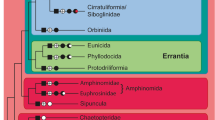Abstract
Investigations by scanning and transmission electron microscopy and freeze-etching revealed that eyes of adultRhipicephalus evertsi mimeticus consist of a lens and photoreceptor cells, which are separated by an acellular layer and the hypodermis. The lens contains numerous pore channels, which open beneath the epicuticula of the outer portion, converge uninterrupted to the inner closure and end in approximately 420 pore fields. The inner closure of the lens is formed as a deep circular invagination. Beneath the hypodermis and perpendicular to the lens, a group of approximately 20 highly differentiated photoreceptor cells in a rosette-like arrangement is localized within the invagination of the lens. Each photoreceptor cell is characterized terminally by numerous, tightly packed and parallel-running microvilli, which are oriented perpendicularly to the lenticular pore channels.
Similar content being viewed by others
References
Bonnet A (1907) Recherches sur l'anatomie compareé et le developpement des Ixodides. Ann Univ Lyon 19: 1–180
Carroll JF, Pickens LG (1986) Ticks react to colors to hitch a ride. USDA News Feature. News Division, U.S. Department of Agricture, Washington DC
Carroll JF, Pickens LG (1987) Spectral sensitivity to light of two species of ticks (Acarina: Ixodidae). Ann Entomol Soc Am 80: 256–262
Dethier VG (1957) The sensory physiology of bloodsucking arthropods. Exp Parasitol 6: 68–122
Douglas JR (1943) The internal anatomy ofDermacentor andersoni Stiles. Univ Calif Publ Entomol 7: 207–230
El Shoura SM (1988) Fine structure of the sight organs in the tickHyalomma (Hyalomma) dromedarii (Ixodidea: Ixodoidae). Exp Appl Acarol 4: 109–116
Gossel P (1935) Beiträge zur Kenntnis der Hautsinnesorgane und Hautdrüsen der Cheliceraten und der Augen der Ixodiden. Z Morphol Oecol Tiere 30: 177–205
Gothe R, Gold Y, Kraiß A (1986a) Zur subspezifischen Validität vonRhipicephalus evertsi mimeticus Dönitz, 1910. Zentralbl Veterinaermed Reihe B 33: 47–59
Gothe R, Gold Y, Kraiß A (1986b) Zur Entwicklungs- und Reproduktionsbiologie vonRhipicephalus evertsi mimeticus Dönitz, 1910: 1. Reproduktionsbiologie. Zentralbl Veterinaermed Reihe B 33: 117–132
Gothe R, Gold Y, Kraiß A (1986c) Zur Entwicklungs- und Reproduktionsbiologie vonRhipicephalus evertsi mimeticus Dönitz, 1910: 2. Entwicklungsbiologie. Zentralbl Veterinaermed Reihe B 33: 133–139
Gothe R, Gold Y, Bezuidenhout JD (1986d) Investigations into the paralysis inducing ability ofRhipicephalus evertsi mimeticus and that of hybrids between this subspecies andRhipicephalus evertsi evertsi. Onderstepoort J Vet Res 53: 25–29
Gothe R, Koch B, Leuterer G (1989) Zur Sensitivität vonArgas (Persicargas) walkerae auf optische Strahlung sowie zur Lokalisation und Organisation lichtperzipierender oder-durchlässiger Areale des Integumentes. Zentralbl Veterinaermed Reihe B 36: 303–313
Ivanov VP, Leonovich SA (1983) Sensory organs. In: Balashov Yu S (ed) An atlas of ixodid tick ultrastructure. Zoological Institute, USSR Acadency of Science. Nauka Publications, Leningrad 1979. Special Publication, Entomological Society of America
Kaltenrieder M, Labhart T, Hess E (1988) Spektrale Empfindlichkeit und Sehfeld der ZeckenartenHyalomma dromedarii undAmblyomma variegatum. Kurzfassung, 13. Tagung der Deutschen Gesellschaft für Parasitologie, Neuchatel 22.–25. März 1988
Kaltenrieder M, Labhart T, Hess E (1989) Spectral sensitivity, absolute threshold and visual field of two tick species,Hyalomma dromedarii andAmblyomma variegatum. J Comp Physiol A 165: 155–164
Karnovsky MS (1965) A formaldehyde-glutaraldehyde fixative of high osmolarity for use in electron microscopy. J Cell Biol 27: 137A-138A
Leonovich SA (1979) Über die Ultrastruktur des Auges bei der ixodiden ZeckeHyalomma asiaticum. Zool Zh 58: 437–439
Leonovich SA (1986) The oriental behaviour of the tickHyalomma asiaticum in a desert. Parasitologiya 20: 431–439
Nosek J, Ciampor F (1973) Contribution to the knowledge of tick-eyes. Sonderh Wiss Arb Burgenland 1: 126–129
Phillis WA, Cromroy HL (1977) The microanatomy of the eye ofAmblyomma americanum (Acari: Ixodidae) and resultant implications of its structure. J Med Entomol 13: 685–698
Schulze P (1948) Vergleichend-morphologische Untersuchungen über die Augen der Schildzecken. Eine Zusammenfassung. Sonderdruck, Verhandlungen der Deutschen Zoologischen Gesellschaft. Kiel, Geest und Portig, Leipzig, pp 90–95
Schulze P (1951) Vergleichend-morphologische Untersuchungen über die Augen der Schildzecken. Zool Jahrb 71: 289–324
Vitzthum H (1925) Die Ceylon-Zecken der Sammlung Plate nebst Bemerkungen über das Auge vonAmblyomma clypeolatum Neumann 1899. Jenaer Z Naturwiss 62: 261–276
Author information
Authors and Affiliations
Rights and permissions
About this article
Cite this article
Gothe, R., Göbel, E. & Schöl, H. On the morphology and organization of the eye of unfed adultRhipicephalus evertsi mimeticus (Acari: Ixodidae). Parasitol Res 76, 428–434 (1990). https://doi.org/10.1007/BF00933552
Accepted:
Issue Date:
DOI: https://doi.org/10.1007/BF00933552




